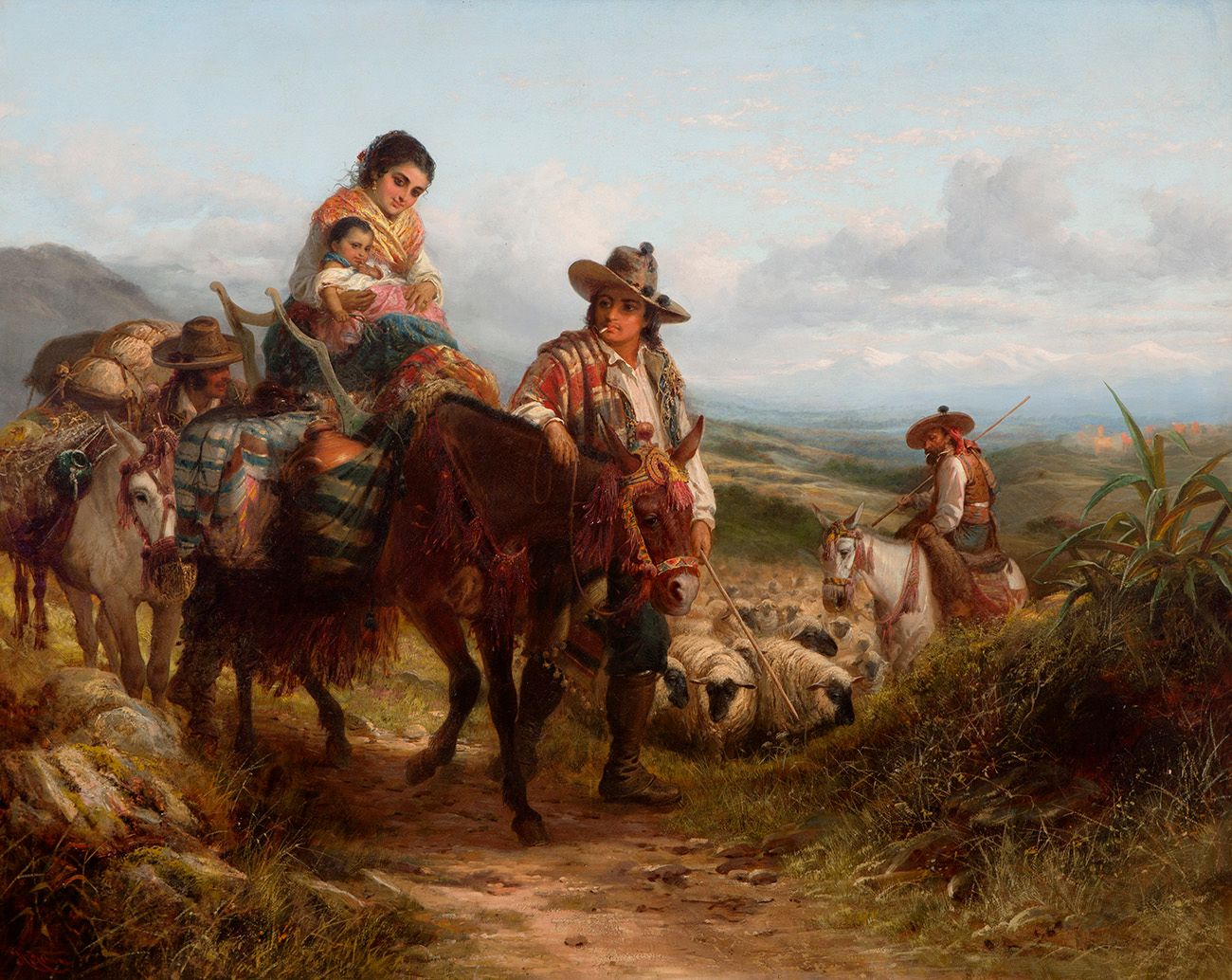Description
ROBERT KEMM (Salisbury, England, 1837 - London, 1895). "A Stop on the Road, with Granada in the Background. Oil on canvas. Signed in the lower left corner. Size: 101 x 127 cm; 146 x 172 cm (frame). Son of the carver and gilder William Kemm, his interest in painting must have awakened very early, as at the age of only fourteen he is registered in the census as an artist. During his early years Kemm produced two series of 256 watercolours of Wiltshire churches. Following his contemporaries J. Phillip, J. Bagnold Burgess and E. Long, Kemm made a trip to Spain in the years between 1955 and 1955. Long, he made a trip to Spain between 1861 and 1864, visiting Seville and Granada in particular. In the years preceding his first exhibition, Kemm devoted himself mainly to portraiture. His first exhibition at the Royal Society of British Artists took place in 1874. In this first exhibition Kemm already displayed all the typical elements of his style, with works on Spanish themes. It is worth mentioning the presentation of several works by Kemm in the exhibition "English Romantic Painters in 19th century Spain", organised in Zamora by Caja Duero in 1999, from a private Spanish collection. Robert Kemm is represented in the Fine Arts Museum of San Francisco, the Salisbury Museum, the Wiltshire Archaeological Society, Sunderland Museum and Sheffield Museum. During the 19th century, Spain and England maintained a special relationship. Britain's valuable support for patriotic fervour in the face of the French invaders led the Spanish to look sympathetically on the British. For their part, British painters and writers descended upon Spain, which offered them the quintessence of romantic idealism. Perhaps seeking a more authentic, natural landscape, they travelled to the peninsula, where the Industrial Revolution had not yet degraded the face of the landscape. Progress in communications made Spain an exotic yet nearby destination for the young English painters who rejected the industrial bourgeoisie and the poverty of spirit that was engulfing the ever-growing big cities. In fact, after the War of Independence, our country began to acquire an aura of exoticism and extravagance that attracted a good number of English intellectuals and artists. Moorish Andalusia, the bandit, the obscurantist Church, the handsome bullfighter and the maja, the lady in a mantilla, the barefoot children, the beggar in rags, Cervantes' gypsy girl... Paintings such as the one we present here bring us closer to the essence of Romanticism, to the exaltation of the soul as a response to an era that placed the cloth on the altar of Reason. To achieve this aim, Romantic painters ceased to subordinate colour to drawing, thus reproducing pictorial motifs with greater expressive force and greater naturalism. The brushstroke became more impetuous, the colour became more autonomous, the impasto was thicker, etc.
77
ROBERT KEMM (Salisbury, England, 1837 - London, 1895). "A Stop on the Road, with Granada in the Background. Oil on canvas. Signed in the lower left corner. Size: 101 x 127 cm; 146 x 172 cm (frame). Son of the carver and gilder William Kemm, his interest in painting must have awakened very early, as at the age of only fourteen he is registered in the census as an artist. During his early years Kemm produced two series of 256 watercolours of Wiltshire churches. Following his contemporaries J. Phillip, J. Bagnold Burgess and E. Long, Kemm made a trip to Spain in the years between 1955 and 1955. Long, he made a trip to Spain between 1861 and 1864, visiting Seville and Granada in particular. In the years preceding his first exhibition, Kemm devoted himself mainly to portraiture. His first exhibition at the Royal Society of British Artists took place in 1874. In this first exhibition Kemm already displayed all the typical elements of his style, with works on Spanish themes. It is worth mentioning the presentation of several works by Kemm in the exhibition "English Romantic Painters in 19th century Spain", organised in Zamora by Caja Duero in 1999, from a private Spanish collection. Robert Kemm is represented in the Fine Arts Museum of San Francisco, the Salisbury Museum, the Wiltshire Archaeological Society, Sunderland Museum and Sheffield Museum. During the 19th century, Spain and England maintained a special relationship. Britain's valuable support for patriotic fervour in the face of the French invaders led the Spanish to look sympathetically on the British. For their part, British painters and writers descended upon Spain, which offered them the quintessence of romantic idealism. Perhaps seeking a more authentic, natural landscape, they travelled to the peninsula, where the Industrial Revolution had not yet degraded the face of the landscape. Progress in communications made Spain an exotic yet nearby destination for the young English painters who rejected the industrial bourgeoisie and the poverty of spirit that was engulfing the ever-growing big cities. In fact, after the War of Independence, our country began to acquire an aura of exoticism and extravagance that attracted a good number of English intellectuals and artists. Moorish Andalusia, the bandit, the obscurantist Church, the handsome bullfighter and the maja, the lady in a mantilla, the barefoot children, the beggar in rags, Cervantes' gypsy girl... Paintings such as the one we present here bring us closer to the essence of Romanticism, to the exaltation of the soul as a response to an era that placed the cloth on the altar of Reason. To achieve this aim, Romantic painters ceased to subordinate colour to drawing, thus reproducing pictorial motifs with greater expressive force and greater naturalism. The brushstroke became more impetuous, the colour became more autonomous, the impasto was thicker, etc.
